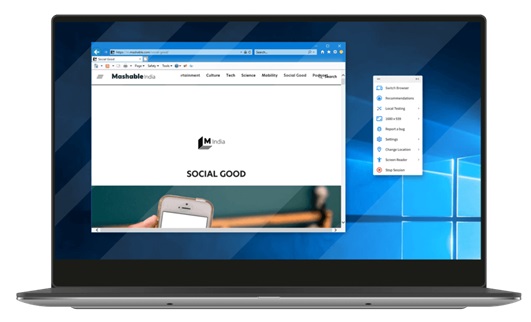Cross-device testing is essential as the number of devices and screens grows. User dissatisfaction, lower engagement, and financial loss may result from inconsistent experiences. Thus, cross-device testing best practices are vital to ensuring your digital solutions meet customer expectations across all platforms.
We will cover cross-device testing, its challenges, and best practices to ensure device consistency. This blog will help you offer a seamless user experience on all platforms. We will focus on planning, strategy, automation, and device testing.
Cross-Device Testing: An Overview of Key Aspects
Here are some of the key aspects of cross-device testing:
-
Functionality Testing
- Purpose: Ensure every feature works as planned on various devices.
- Focus Areas: interactive elements, form submissions, navigation, and clickable elements.
-
Responsive Design Testing
- Purpose: Ensure the layout and design adapt to different screen sizes and resolutions.
- Focus Areas: text readability, image scaling, and overall visual presentation.
-
Performance testing
- Purpose: Measure performance under different conditions, including network speeds and device capabilities.
- Focus Areas: load times, responsiveness, and smoothness of interactions.
-
Compatibility testing
- Purpose: Ensure the program works with various browsers, operating systems, and device setups.
- Focus Areas: Hardware differences, operating system variations, and cross-browser compatibility.
Challenges in Cross-Device Testing
Cross-device testing is crucial but difficult. Here are the main challenges:
-
Device Fragmentation
- Description: Making sure that the content translates smoothly in one device, operation system, and resolution and the other.
- Impact: Testing on many devices is somewhat time-consuming and costly since the devices have to be purchased.
-
Operating System Variations
- Description: Windows OS, Mac OS, Linux distros, iOS and Android have distinguished features.
- Impact: New variants are untested where there is desire, which in OS development makes things harder.
-
Browser Compatibility
- Description: Software should be compatible with the browsers that are often used today such as Chrome, Firefox, Safari, Edge, etc.
- Impact: Browsers interpret HTML, CSS, and JavaScript in a different way and thus there are problems.
-
Network Conditions
- Description: Users use applications in varying network connectivity: some at very high internet connectivity such as Wi-Fi and others in low internet connectivity such as mobile internet.
- Impact: Network speed is an essential aspect since performance and functionality differ with the rate of a network. Thus, testing under varying conditions is possible.
-
Hardware Differences
- Description: Mobular differs regarding the speed of the central processor, the memory, and discretion.
- Impact: Issues that involve different platforms should be tested in different apparatuses to improve reliability.
-
Touch and Non-Touch Interfaces
- Description: These can include a touch screen, keys, or a mouse.
- Impact: That is why the creators of the front end face a very difficult task when it comes to guaranteeing the UI’s compatibility with any type of input.
-
Screen Sizes and Resolutions
- Description: The sizes and densities of the screen will determine how an application will look like.
- Impact: Responsive design testing helps to determine if the content and layout of the page will adapt as it should.
-
Battery Performance
- Description: Different mobile devices are characterized by varied battery capacities and power settings.
- Impact: Testing shall also cover the fact that such an app keeps the battery scrutinized with the aim of not overloading it.
-
Automation Complexity
- Description: As it has been earlier noted, devices act in various ways and hence this makes the process of automated testing very difficult.
- Impact: It is always difficult, and requires certain experts to create dependable test automation, for all devices.
-
Resource Intensive
- Description: Cross-browser testing requires a lot of devices to be used.
- Impact: Maintaining a device lab or outsourcing tests with cloud-based services requires a significant amount of time and money.
Setting Up A Cross-Device Testing Environment
Building a cross-device testing environment that works well is essential to making sure your application works well on a variety of platforms and devices. To create a reliable cross-device testing environment, follow these essential steps:
-
Create a Comprehensive Test Plan
Define Scenarios and Test Cases: Explain all the set of user interactions and all the edge scenarios. Confirm usability, performance, and functionality on different devices before launch.
Prioritize Crucial Features: They should focus more on the features that would have a big influence or increase the user experience.
-
Identify and Prioritize Target Devices
User Analytics: Looking at the visitor reports you can identify which operating systems, browsers, and devices are used most often by your audience. Prioritize these for testing.
Market Research: While establishing market coverage, look at Which markets to target and look at which devices dominate these markets to take full coverage.
-
Prepare a Device Lab
Physical Device Lab: It is important to stock a lab with laptops computers, tablets, and phones. This is time-consuming but gives more accurate testing runs.
Cloud-Based Device Lab: Use AI-powered test orchestration and execution platforms like LambdaTest to test on remote test lab. By providing access to many devices and browsers, these solutions enable scalable and effective testing.
-
Use Emulators and Simulators
Emulators: While good for general testing and initial checks, the compact size of these scopes is not ideal for serious astronomy. They imitate the device contexts, but could potentially omit certain hardware-related challenges.
Simulators: The former is especially useful in iOS devices. They mimic real device behavior but they are not very accurate instruments.
-
Implement Responsive Design Testing
Fluid Layouts: When it comes to designing, do pay specific attention to the variation in screen size and resolution.
Viewport Testing: Check for responsive design and review how the content looks on the screen by resizing the browser as a test.
-
Automate Testing Processes
Automation Tools: To increase the number of iterations while executing lengthy, repetitive test cases, make use of technologies such as Selenium or Appium.
CI/CD Integration: Include the test automation as a part of the CI/CD process. This makes it possible to run tests regularly hence any issues arising are quickly pointed out.
-
Perform Performance Testing
Load Testing: Test response time and other performance characteristics on different platforms and with various network latencies.
Network Simulation: Performance testing under these conditions is useful so that one can simulate conditions under which the application will be used before deploying it.
-
Conduct Accessibility Testing
Inclusive Design: Check browser compatibility with assistive technologies like screen readers, and keyboard navigation, among others.
Compliance Standards: WCAG, to enhance compliance, should be followed with strict adherence.
-
Monitor and Analyze Test Results
Data Collection: This involves examining test results for similar problems or anomalies that may exist in the application.
Reporting: By having various reports, you can track and share the results and your team’s performance easily.
-
Continuous Learning and Improvement
Stay Current: Keep up with the latest cross-device testing tools, trends, and best practices.
Iterate and Improve: Adjust your testing strategy based on feedback and results.
Best Practices For Cross-Device Testing
Maintaining a uniform user experience on several devices is challenging but crucial. The following practices will help ensure consistency and speed up the cross-device testing process:
-
Planning and Strategy
- Platforms and Devices to Target: On the same token, one should know which operating system, browser, and device his consumers are most inclined to. they should receive much attention when practicing your test plan.
- Set Priorities Based on User Data: This approach of developing a statistical visualization of device usage means that efficiency can be evaluated and targeted on those that have the most traffic and impact. What are the primary platforms or devices your audiences are using?
-
Use a Mix of Emulators and Real Devices
- Emulators: The first method to implement is using emulators for quick testing. There are a number of different types and settings of devices across the full spectrum of possibilities. It is cheaper than actually developing the application, and the learning process can be accelerated if used appropriately in the initial stages of testing.
- Genuine Devices: At this, it makes sense to check the findings on genuine devices to ensure the quality of the work done and the opportunity to improve competencies. It is also important to note that faults specific to the emulation of hardware can be overlooked by emulators.
-
Responsive Design Testing
- Fluid Layouts: Design a mobile application that should be suitable for any Android or iOS device comprising different resolutions and sizes.
- Testing Viewport and Screen Size: When it comes to responsive design, always check your application on a variety of viewports in order to test for the proper display of content when viewed through various devices.
-
Automate Where Possible
- Automation: For efficient testing of long, repetitive, and monotonous test cases, utilize tools like Selenium or Appium.
- Regression Testing: Use regression testing with automated software to identify as many problems as possible in the updated versions.
-
Cross-Browser Testing
- Browser Compatibility: It is also advised to test your app on multiple browsers to possibly see a switch in behavior. This part highlights only Edge which belongs to the Windows operating system, Chrome developed by Google, Firefox by Mozilla, and Safari by Apple.
-
Performance Testing
- Load Times: Why and How to Measure and Improve Load Time across Devices and Networks to Deliver a Responsive / Faster User Experience?
- Network Simulation: This means that you can throttle or emulate slow and flaky connections for your application to ensure that it can perform and remain functional in impoverished network circumstances.
-
Accessibility Testing
- Inclusive Design: Your software, your product, your application, and your program should be accessible to the disabled. Test keyboard navigation. Ensure that Your Design and Content is Affordable for Test Screen Readers and Other Assistive Technology.
- Compliance Standards: The Internet pages adhere to the WCAG guidelines in order to guarantee barrier-free accessibility.
-
Continuous Integration and Continuous Deployment (CI/CD)
- CI/CD Integration: After each code is committed, integrate testing automation. Cross-device tests should be included in the CI/CD pipeline. The benefits of Test automation in Cross-device are as follows: It is effective in ensuring quality, and there are no delayed issues for quality to be identified.
- Frequent Testing: Regular cross-platform testing is good to perform. Some of the Guidelines for Software Development which are as follows.
-
Create a Comprehensive Test Plan
- Define Test Cases and Scenarios: Develop a good number of ideas on test cases. Consider every opportunity for interaction with the user and ensure that there is an acknowledgment of all the edge cases.
- Set Priorities for Critical Features: These are some of the recommendations to consider when choosing the features to be tested, namely, focus on the aspects with the greatest effect on user experience.
-
Utilize Cloud-Based Testing Solutions
- Cloud Device Labs: To access various devices without keeping up a physical device lab, use cloud-based device labs.
- Scalability: To conduct parallel tests on several devices at once, use the scalability provided by cloud solutions.
That is why as the number of devices and, consequently, the combinations increase, the task of internal devices may become unaffordable. It is usually convenient and economical to ‘go to the cloud’ for many settings and devices that are otherwise burdensome to transport.
That is why, platforms like LambdaTest that rely on AI to make the devices available for testing can help. This is appropriate for large updates or high delta times. LambdaTest offers cross-browser testing that is both automatic and manual and is compatible with a variety of devices and browsers. This guarantees stability in the usability of the website to the end users or clients. CI/CD technologies can be easily integrated with the use of the platform. This makes the job of testing easier, and it is also easier to single out problems and solve them as soon as possible during the development process.
LambdaTest enhances test fronts, cross-browser testing, and product quality. This saves time and money for the owner while giving him or her an opportunity to compete effectively in the rapidly growing new digital world.
Conclusion
In the present age of dynamic websites and applications, there is a need for cross-device testing. This makes it possible for a homogenized approach to be used, thereby establishing a consistent and seamless feel for the user. Given the current trends of increasingly complex and diverse devices, it is significant to emphasize cross-testing best practices to ensure an outstanding level of user experience.
Cross-device testing can be handled by teams by challenge identification. Plan strategically. Actual devices should be utilized alongside emulators. Automate processes. Use cloud-based testing solutions. You should also mention cross-browser, performance testing, and accessibility testing. This enhances the reliability and stake of applications as well.
It is also essential to include cross-device testing in your continuous integration and continuous delivery pipeline. Periodic assessment of test outcomes means all issues are detected and addressed in due time. This ensures application quality is maintained as the new releases are developed and rolled out.
Implementing these best practices increases the level of consumer satisfaction. It promotes your brand to become of better quality and more reliable. This puts you in a good position to compete with other players in the market.


















